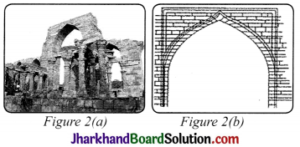JAC Board Class 7 Social Science Notes Geography Chapter 7 Human Environment: Settlement, Transport and Communication
→ Places where people build their homes are called as settlements. The settlements grew near the river valleys as water was available and land was fertile. The civilizations that grew along the banks of rivers were Indus, Tigris, Nile and Hwang-He.
→ Settlements are of two types:
- permanent or
- temporary.
![]()
→ Temporary settlements
- Temporary settlements are the settlements which are occupied for a short time.
- The people who live in deep forests, hot and cold deserts and mountains often dwell in the temporary settlements.
→ Permanent settlements are the settlements where people build homes to live in.
- The villages are rural settlement where people are occupied in activities such as agriculture, fishing, forestry, crafts work and trading. These type of settlements can be compact or scattered.
- A closely built area of dwellings wherever flat land is available is known as a compact settlement.
- A scattered settlement is a settlement where dwellings are spaced over an extensive area. It is mostly found in hilly tracts, thick forests and regions of extreme climate.
- People build houses to suit their environment in rural areas. In regions of heavy rainfall, they have slanting roofs as the houses are constructed on a raised platform or stilts.
- Thatched roofs are common in areas of hot climate which have thick mud walled houses. Local materials such as stones, mud, clay, straw, etc., are used to construct houses.
- The people are engaged in manufacturing, trading, and services in urban settlements.
→ Transport
- The means by which people and goods move is known as transport.
- Transport was made easier by the invention of the wheel.
- Different means of transport was developed but even today people use animals for transport.
- The animals such as donkeys, mules, bullocks and camels are used for transport in India. Whereas, in the Andes Mountains of South America, llamas are used and yaks are used in Tibet.
- The early traders took either the sea route or the land route from other countries to reach India which took many months. Modem means of transport such as airplanes have made travel faster. It takes only 6-8 hours to travel from India to Europe and hence saves time and energy.
- The four important means of transport are:
- roadways
- railways
- waterways
- airways.
→ Roadways
- The most used means of transport for short distances are roads. They can either be metalled (pucca) or unmetalled (kutcha).
- Roads have also been built in territories such as deserts, forests and even high mountains. One of the highest roadways in the world is Manali-Leh highway in the Himlayan Mountains.
- Subways or under paths is the roads built underground. Roads which are built over raised structures are known as flyovers.
→ Railways
- The Industrial Revolution and invention of the steam engine helped in rapid growth and development of rail transport.
- In course of time, the steam engines have been replaced by diesel and electric engines. In many places to make the journey faster, superfast trains have been launched.
- The network of Indian railway is the largest in Asia and well developed.
→ Waterways:
- The cheapest means of transport for carrying heavy and bulky goods over long distances are the waterways.
- There are two types of waterways
- inland waterways and
- sea routes.
- Inland waterways are navigable rivers and lakes. The Ganga-Brahmaputra river system in India, the Great Lakes in North America and the Nile river in Africa are some of the major inland waterways.
- For transporting merchandise and goods from one country to another, sea routes and oceanic routes are mainly used and are connected with the ports.
- Singapore and Mumbai in Asia, New York, Los Angeles in North America, Rio
de Janerio in South America, Durban and Cape Town in Africa, Sydney in Australia, London and Rotterdam in Europe are some of the major ports of the world.
![]()
→ Airways
- The fastest way of transport is the airways which has been developed in the early twentieth century. It is the most expensive and exorbitant due to high cost of fuels.
- To reach the most remote and distant places specially where there are no roads and railways, this mode of transport is used.
- Due to bad weather such as fog and storms, air traffic is adversely affected and very troublesome.
- Some of the major airports are Delhi, Mumbai, New York, London, Paris, Frankfurt and Cairo.
- Helicopters are very useful in most inaccessible areas.
→ Communication
- The process of conveying messages to others is known as the communication.
- Different modes and means of communication are used to provide information, to educate as well as to entertain people.
- Mass media contains newspapers, radio and television so that we can communicate with a large number of people.
- Satellites made the communication even more faster and have helped in oil exploration, survey of forest, underground water, mineral wealth, weather forecast and disaster warning.
- Now-a-days, we can send electronic mails or e-mails through Internet.
- Cellular phones are the wireless telephonic communications which have become very popular nowadays.
- Internet had made our lives more comfortable and easier and also provides us
with worldwide information and interaction. We can book tickets for movie or reserve a resort or hotel online. - We have become a large global society due to interconnectivity of people, services and institutions all across the world.
